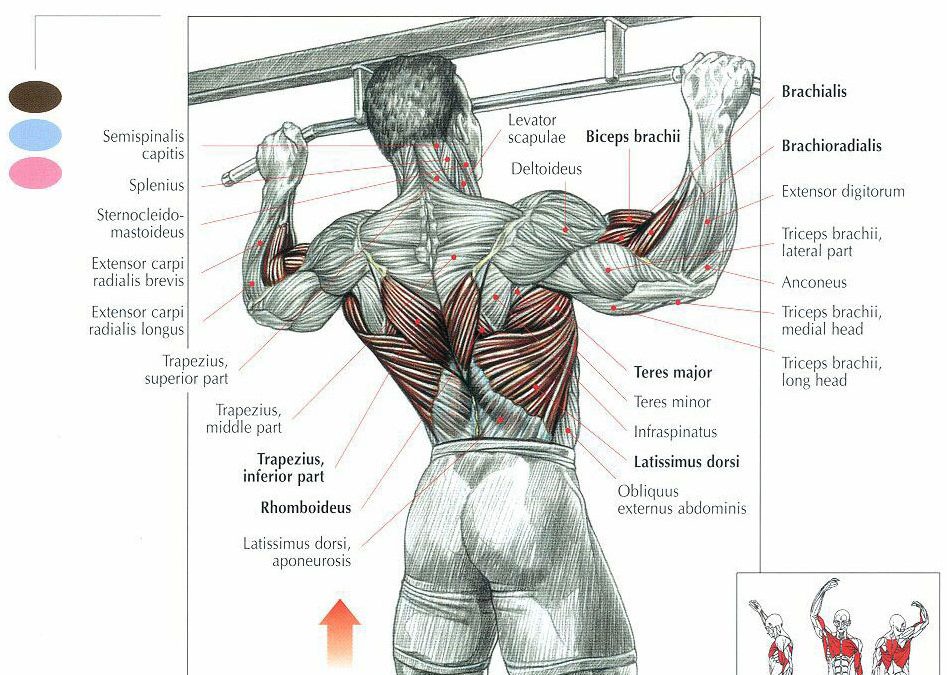Pull-up is an upper-body, compound exercise. Your back and arms pull your body up while your abs prevent your lower back from arching.
You can emphasize your arms by gripping the bar with your palms facing up. These are Chinups and they’re effective for building bigger arms.
If you can’t do a single Pull-up, try Chin-ups.
Grip the bar with your palms facing up, this is easier. If you can’t do a Chinup either, do negatives.
Jump up over the bar and lower yourself slowly. You can also use a resistance band or spotter to help you on the way up. But don’t use machines.
Mistakes
When you do pull-ups you should always aim for a full range of motion.
Do not only use the upper or lower part of the movement and go into a full extension of your arms at the bottom.
A pull-up should also be performed with strength and not with momentum avoid any form of kicking and swinging, of course.
It’s also important to control the movement the whole time don’t let yourself fall into your joints.
The last mistake is to not pull evenly you should control yourself to pull with both sides equally to avoid imbalances
Pull-ups: 5 Tips to do
- Grab The Bar. Grip it about shoulder-width apart. Full grip with your palms down.
- Hang. Raise your feet off the floor by bending your knees. Hang with straight arms.
- Pull. Pull yourself up by pulling your elbows down to the floor. Keep your elbows close.
- Pass The bar. Pull yourself all the way up until your chin passes the bar. Don’t do half reps.
- Repeat. Lower yourself all the way down until your arms are straight. Breathe. Pullup again.
Hang on the pull-ups bar of your Power Rack to do Pullups. If it has no pull-up bar, raise the uprights of your Power Rack or Squat Rack as high as you can.
Then put the barbell in the uprights and hang from it to do Pullups. If you have no Power Rack, get a doorway pull-up bar.
Once you have a bar to hang from, follow these five simple steps to do Pullups with proper form.
If you lack the strength to do one Pullup, do negatives. Get your chin over the bar by standing on the bench or the safety pins of your Power Rack.
Lower yourself slowly and then jump up again for the next rep. You can also loop a resistance band around your leg to help you up.
Or you can ask someone to help you by holding your legs. But don’t use assisted Pullup machines. The best way to get stronger at Pull-ups is to do Pullups.
Pull-up position
- Grip. Full grip. Face your palms away. Hold the bar high, close to your fingers.
- Grip Width. Your hands should be about shoulder-width apart. Don’t grip too wide.
- Elbows. Keep them 45° in like when you Overhead Press. Don’t flare your elbows out.
- Chest. Raise your chest. Lead with it on the way up. Try to touch the bar with your chest.
- Shoulders. Keep them back. Don’t roll them forward. Don’t squeeze your shoulder-blades.
- Head. Keep it neutral. Look forward. Don’t look at the bar. Don’t reach for it with your head.
- Lower Back. Stay neutral. Straight line shoulders to knees. Don’t over-arch your lower back.
- Legs. Bend your knees to keep your feet off the floor. Cross your legs and squeeze your glutes.
- Bottom. Hang with straight arms and locked elbows. Shrug your shoulders towards the ceiling
- Way Up. Pull yourself up by pulling your elbows down and to the floor. Lead with your chest.
- Top. Get your chin over the bar. Keep your head neutral. Don’t pull it forward to the bar.
- Way Down. Lower yourself all the way down until your arms are straight at the bottom.
- Breathing. Take a big breath at the bottom, hold it at the top, exhale/inhale at the bottom.
Muscles Worked
Upper-back
Your latissimus dorsi aka lats pull your upper-arms down to pull yourself up.
Your lats are your broadest back muscle that creates a “v-shape” look. Pull-ups also work your traps, rear shoulders and various small muscles in your upper-back.
Arms
Your biceps bends your elbows to pull yourself up.
In fact, biceps works hardest when you do chin-ups with your palms up.
Specifically, forearms muscles also work to bend your elbow and to hold you on to the bar.
Your triceps pulls your elbows back towards your torso.
Abs
Your ab muscles prevent your lower back from arching while you pull yourself up.
They maintain a straight line from your shoulders to your knees.
This works the “six-pack” muscle that runs over your belly, your rectus abdominus. Eat right and they’ll show.
6 Types of Pull-ups
Chin-up
In a classic pull-up, grip the overhead bar with your palms facing away from you. In a chin-up, grip the bar with your palms facing towards you.
The grip adjustment places more stress on the biceps, helping build bigger, stronger arms.
Grip Width
Simply altering the width of your grip will have a tremendous effect on pull-up performance.
Grasping the bar with your hands closer together will place greater emphasis on the arms, shoulders, and chest.
Grasping the bar with your hands farther apart will work the lat muscles of the back.
Commando Pull-up
In a commando pullup, turn your body and stand so you’re looking down the length of the bar.
Grab the bar with your palms facing each other in a staggered position.
This is known as a neutral grip and places less stress on the shoulders.
When you pull yourself up, you’ll have to move your head to one side or the other to avoid hitting the bar.
Alternate sides with each rep. Commando pullups target the arms and chest.
Dead Hang
To perform a dead hang pullup, lower your body until your arms are completely extended at the bottom of each rep.
Allow yourself to hang until all momentum is lost before pulling yourself back up. This adds a greater degree of difficulty to the exercise.
Behind the Neck
While they shouldn’t be attempted by those with rotator cuff problems or existing shoulder issues, behind the neck pullups blast the shoulders and upper back, providing an intense workout.
Instead of pulling your chin over the bar, you duck under and lift your head up on the other side, touching the bar to the back of your neck.
Australian Pull-ups
This pull-up variation uses a bar that’s only about waist high. Instead of hanging vertically beneath the bar, you assume a horizontal position with your legs in front of you and in constant contact with the ground.
When you pull yourself up from this horizontal plane, you’re taxing the muscles in your rear lats and mid-back that may not be tested with normal pull-ups.













